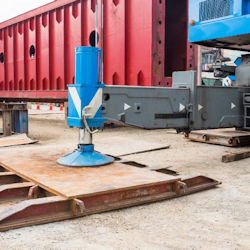Annual/Comprehensive Inspections
It's important that the employer conduct annual comprehensive inspection of cranes and crane equipment to ensure they don't fail to work properly.
Should you inspect the outrigger and stabilizer pads for excessive wear or cracks during an annual inspection?
The annual inspection must also include:
- hydraulic and pneumatic valves, as follows:
- spools (sticking, improper return to neutral, and leaks);
- leaks;
- valve housing cracks;
- relief valves (failure to reach correct pressure - if there is a manufacturer procedure for checking pressure, it must be followed);
- hydraulic and pneumatic cylinders, as follows:
- drifting caused by fluid leaking across the piston;
- rod seals and welded joints for leaks;
- cylinder rods for scores, nicks, or dents;
- case (barrel) for significant dents;
- rod eyes and connecting joints (loose or deformed);
- outrigger or stabilizer pads/floats for excessive wear or cracks;
- slider pads for excessive wear or cracks;
- electrical components and wiring for cracked or split insulation and loose or corroded terminations;
- warning labels and decals originally supplied with the equipment by the manufacturer or otherwise required under the standard (missing or unreadable);
- originally equipped operator seat or equivalent (missing);
- operator seat (unserviceable);
- originally equipped steps, ladders, handrails, or guards (missing);
- steps, ladders, handrails, or guards (in unusable/unsafe condition);
- for tower cranes, all turntable and tower bolts must be inspected for proper condition and torque; and
- for derricks, gudgeon pins for cracks, wear, and distortion, and foundation supports for continued ability to sustain the imposed loads.
Knowledge Check Choose the best answer for the question.
5-5. What should be checked for excessive wear and cracks during an annual crane inspection?
You forgot to answer the question!

